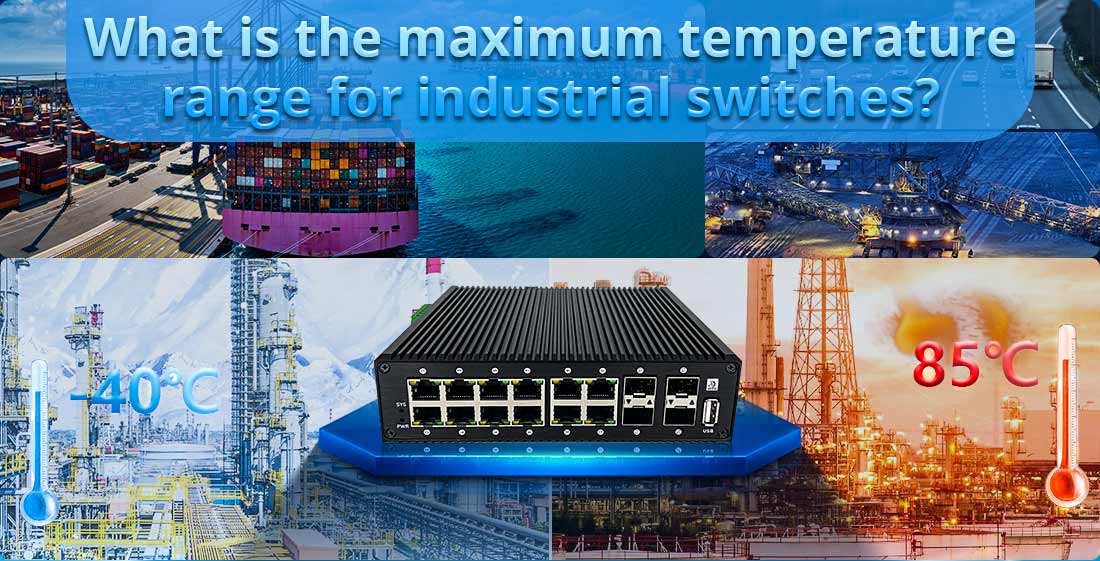
Industrial switches are designed to operate in extreme environments, including both very high and very low temperatures. The maximum temperature range for industrial switches typically spans from -40°C to +75°C (-40°F to +167°F), although some specialized models can operate in even broader temperature ranges, depending on the specific design and intended application.Here’s a detailed description of the temperature ranges and factors involved:
1. Typical Temperature Range for Industrial Switches
Most industrial switches are rated for a temperature range of -40°C to +75°C (-40°F to +167°F). This wide range makes them suitable for various industrial and outdoor applications where environmental control is limited, and temperature fluctuations are common. The ability to handle both freezing and extremely hot conditions makes them ideal for use in industries such as:
--- Outdoor telecommunications
--- Smart city infrastructure
--- Mining and oil & gas industries
--- Transportation systems (railways, roadways, marine)
--- Manufacturing plants
--- Utilities (wind farms, substations, solar energy systems)
These switches are often placed in environments such as outdoor cabinets, control rooms without air conditioning, or inside heavy machinery, where temperature fluctuations can be intense.
2. Extended Temperature Range Switches
For even more extreme environments, certain industrial switches are specifically designed with an extended temperature range. These models can tolerate temperatures ranging from -40°C to +85°C (-40°F to +185°F) or more. Some highly specialized models can operate at temperatures even higher, although this is less common.
High-Temperature Applications: Industrial switches used in desert climates, near industrial furnaces, or in environments like oil and gas plants may need to endure temperatures that exceed the standard +75°C. These high-temperature models are engineered with enhanced heat dissipation mechanisms and often feature fanless designs to reduce the risk of mechanical failure in hot environments.
Low-Temperature Applications: Switches deployed in cold environments like arctic regions, mountaintop communication stations, or cold storage facilities need to handle temperatures well below freezing. These switches incorporate special materials and designs to ensure that cold conditions do not cause brittleness or affect performance.
3. Cooling and Thermal Management
For switches operating at the upper end of the temperature spectrum, effective thermal management is crucial to ensure long-term reliability and performance. Industrial switches designed for high temperatures include features such as:
Fanless Designs: Many industrial switches designed for harsh conditions use passive cooling methods (i.e., heat sinks or airflow designs) rather than active cooling (i.e., fans) to minimize mechanical parts that could fail in dusty or dirty environments.
Enhanced Airflow: Some switches are built with larger, more ventilated enclosures or metal casings that improve heat dissipation and prevent the device from overheating, even in direct sunlight or enclosed spaces.
Wide Operating Voltage: To help manage power more efficiently and avoid overheating, some industrial switches are designed to operate with a wide range of voltage inputs, which ensures they can maintain stable performance in areas with power fluctuations or surges.
4. Environmental Impact on Lifespan and Performance
While industrial switches can tolerate extreme temperatures, prolonged exposure to such conditions can still impact their lifespan. For example:
High Temperatures: Prolonged exposure to high temperatures can gradually degrade internal components, leading to a reduced overall lifespan, especially if the switch is operating near its upper temperature limit for extended periods. Heat increases the wear and tear on electronic components and can lead to thermal stress if not adequately managed.
Low Temperatures: Extremely low temperatures can cause materials to become brittle, affecting connectors, seals, and other parts of the switch. This is especially relevant in applications where mechanical vibrations are present, as cold conditions can make materials more susceptible to cracking or wear.
To address this, manufacturers often rate their switches for a derated lifespan when operating at the extreme ends of their temperature ranges. In other words, a switch operating at maximum temperature conditions (e.g., +75°C or higher) may have a shorter lifespan than one operating under more moderate conditions.
5. Specialized Certifications for High-Temperature Switches
Many industrial switches designed for extreme temperature environments also meet specialized certifications that validate their performance in such conditions. For example:
ATEX or UL Class 1 Division 2: Certifications like ATEX or UL Class 1 Division 2 certify that industrial switches are safe to use in hazardous environments with extreme temperatures, such as in the presence of explosive gases, dust, or chemicals.
MIL-STD-810G: Some ruggedized switches meet military standards for operating in extreme temperatures, ensuring their performance in demanding environments such as military installations or aerospace applications.
6. Applications for Maximum Temperature Ranges
Industrial switches with wide temperature ranges are commonly used in the following applications:
Energy and Utilities: Power plants, substations, and solar/wind energy systems are often located outdoors or in remote areas where temperature extremes are common. Industrial switches in these environments need to ensure continuous connectivity even during heat waves or cold snaps.
Transportation: Railways, highways, and shipping ports require robust network infrastructure. Switches used in these sectors may be housed in outdoor enclosures exposed to the elements or in onboard systems that experience wide temperature fluctuations.
Mining and Oil & Gas: Industrial switches are often deployed in remote mining sites, oil rigs, and processing plants where temperature extremes (both hot and cold) are frequent.
Outdoor Surveillance: Many outdoor IP cameras, wireless access points, and sensors in surveillance systems are powered and connected through industrial switches. These are often located in unprotected areas and exposed to fluctuating environmental conditions.
Conclusion
The maximum temperature range for most industrial switches is typically between -40°C to +75°C (-40°F to +167°F), but extended temperature models can function in ranges reaching -40°C to +85°C (-40°F to +185°F) or more. These switches are designed with rugged materials, thermal management systems, and durable enclosures to operate reliably in harsh outdoor environments, extreme heat, or freezing temperatures. The specific temperature range required will depend on the application and environmental conditions in which the switch will be deployed.